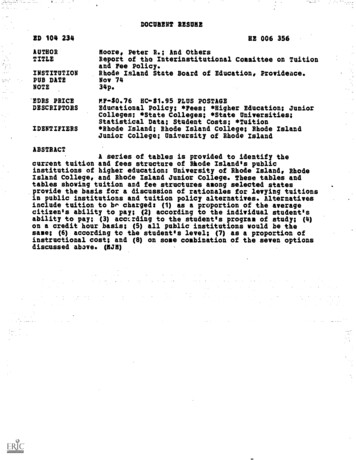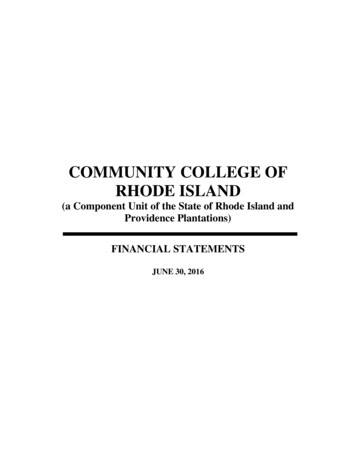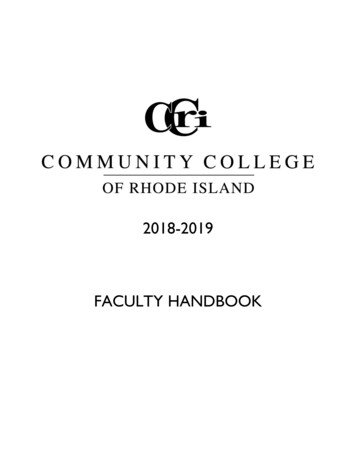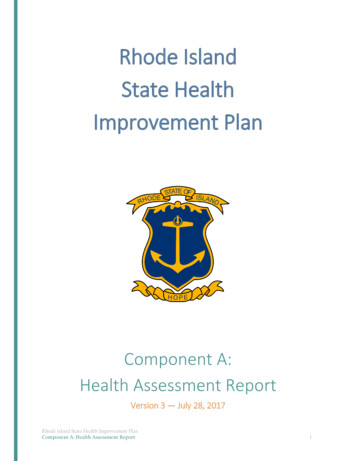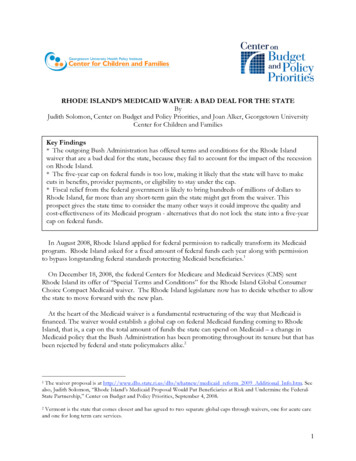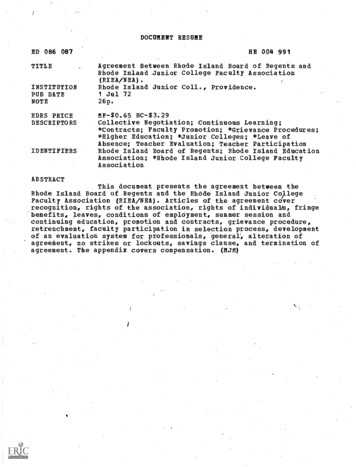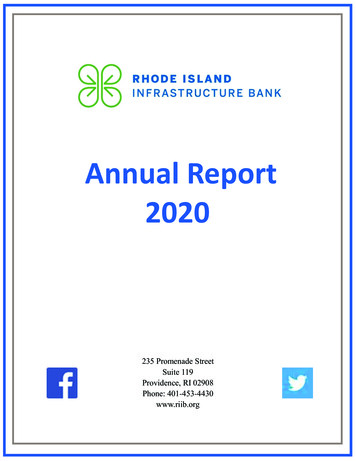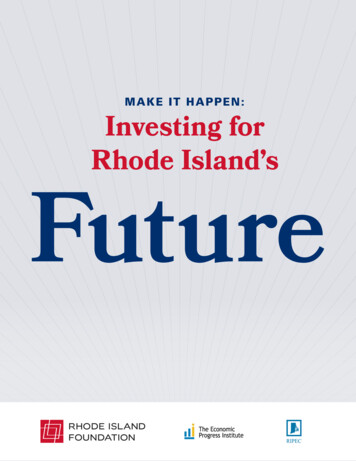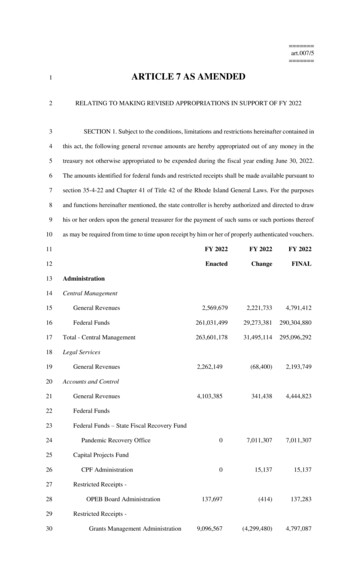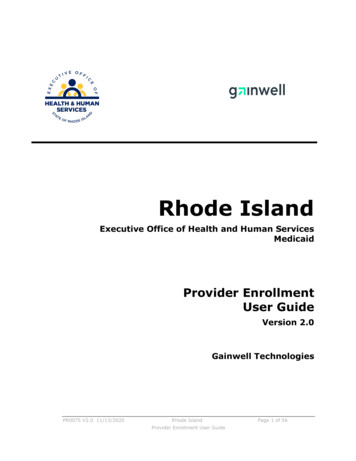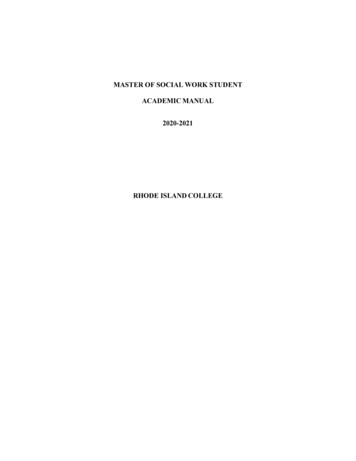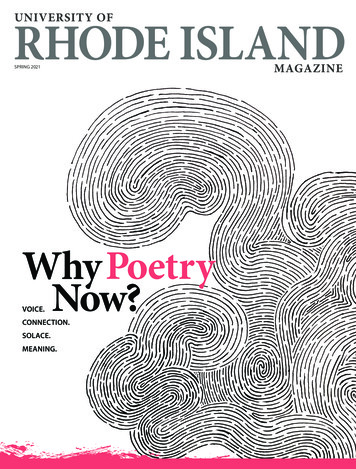
Transcription
RHODE ISLANDUNIVERSITY OFSPRING 2021Why PoetryNow?VOICE.CONNECTION.SOLACE.MEANING.MAGAZINE
ApertureEDWARDS IN BLOOMEdwards Hall is one of URI’s most iconic buildings.Positioned on the Quadrangle at the corner of UpperCollege Road, Edwards was built in 1928 of the samerough, squared, ashlar granite as some of the earlierbuildings on the Quad. Named for URI’s third president,Howard Edwards, the building’s auditorium has served asa lecture hall, been home to URI Theatre, and hostedmovies, concerts, guest speakers, University ceremonies,and lecture series.The building underwent a 1.5 million restorationin 2010, which earned URI a 2012 Rhody Award forHistoric Preservation. During the restoration, workersuncovered a set of murals by Providence artist GinoConti as part of the Works Projects Administrationprogram, which provided jobs to boost the economyduring the 1930s and 1940s. In near perfectcondition, the murals were removed and restored.In 2018, Edwards was one of 17 structureson the Kingston Campus named to theNational Register of Historic Places. Thisdistinction recognizes the URI HistoricDistrict for its contributions to thehistory of education, architecture,and landscape architecture. PHOTO: NORA LEWIS10SPRING 2021UNIVERSITY OF RHODE ISLAND MAGAZINE11
InsideF E AT U R E SUNIVERSITY OF RHODE ISLAND MAGAZINE VOL. 3, NO. 2 SPRING 2021CURRENTS8IN BRIEFURI news to keep youin the know.9GO RHODYMeet recipients of the Ryanand Verrecchia Scholarships.11RHODY SCHOLARSGrad student Lauren Machado’swinning business plan putssustainable fashion forward.12MEDIA SPOTLIGHTURI experts are quoted in themedia frequently. Here are a fewof them that bear repeating.NET WORK46CLASS NOTESURI alumni are amazing!Catch up with your classmatesand get to know the newest andlongest-standing members ofthe Rhody family.51YOUR STORIESThe legacy of the late LeoDiMaio Jr. as told by the lateDaniel Price Jr. ’73.13LESSON PLANThe new URI Online programoffers accessible education forworking students.55CLOSE UPCommunication studiesprofessor Kathleen Torrenswants her students to becomecitizen-participants.15QUAD ANGLESEnglish proffessor TravisWilliams on what Shakespearecan teach us about pandemicsurvival.2SPRING 2021As URI’s College of Nursing marks its 75th year and COVID keeps nurses in the spotlight,we look at the changing profession through the stories of URI’s nursing alumni.52NICHEA Q&A with inventor, author,techie—and Oscar and EmmyAward winner—Tom Ohanian,M.B.A. ’1414WHY I TEACH36THE EVOLUTION OF NURSINGMeet Rachel Gomes,M.E.S.M. ’20, the KingstonFire Department’s firstfemale firefighter clearedfor primary duty.56CAPTION THISStroll down Memory Lane,check out last issue’s winners,and send your best captionfor this issue!Lila Bovenzi ’2210BIG IDEAS. BOLDPLANS.Ryan Kleinert ’12URI athletic director ThorrBjorn on adapting to collegeathletics during COVID.16PRESIDENT DOOLEY’S LEGACY22SOMETHING TO TWEET ABOUT28POETRY’S MOMENTURI has changed in major ways duringthe 12 years of David M. Dooley'spresidency. We take a closer look at 10of the most important changes.Meet some of URI’s student, faculty,staff, and alumni birders—and find outhow they got hooked.From the presidential inaugurationto the Super Bowl, poetry is everywhere—and URI is no exception.Left, Nicholas Larghi ’09 captured this image of a giant sphinx mothdrinking nectar from a ghost orchid in Big Cypress National Preservein Florida's Everglades. His story and photos were published inOrchid Digest. Read Larghi’s Class Note on page 50.COVER ILLUSTRATION: MASON MCMILLENPHOTOS: NICHOLAS LARGHI; JOE GIBLIN; NORA LEWIS; COURTESY RYAN KLEINERT; LILA BOVENZIUNIVERSITY OF RHODE ISLAND MAGAZINE3
FROM THE PRESIDENTThank You, University of Rhode Island.David M. Dooley became the University of Rhode Island’s 11th presidentin 2009. As he prepares to retire this year, President Dooleyexpresses his gratitude for the people of URI.W“Working withthe people of theUniversity ofRhode Island hasbeen the highlightof my career.”—David M. Dooleyorking with the people of theUniversity of Rhode Island hasbeen the highlight of my career. URI’sstudents, faculty, staff, alumni, politicalleaders, and friends have all contributedto the achievements and excellence thatnow characterize our university. Therehave been many challenges over the years,but the determination, perseverance, anddedication of the URI community havepropelled URI to its current status as apremier public research university.In these pages, there are many storiesthat relate to our current experiences aswe continue adapting to life during a pandemic. “From Assistant to Expert: Redefining Nursing” brings into focus theimportance of nurses in roles rangingfrom patient care to leadership duringtimes of crisis. As we commemorate the75th anniversary of URI’s nursing program at a time in history when nurseshave become the face of frontline workers,we highlight the URI nurses in communities around the globe and in every facetof health care who are touching—andsaving—countless lives.Throughout the pandemic, URI hascontinued to expand its commitment tothe arts and the cultural experiences thatconnect us as humans. When AmandaGorman confidently stepped into theinaugural spotlight to share her poem,“The Hill We Climb,” generations of people were reminded of the power of poetryand its ability to connect us on an emotional level. “Why Poetry Now?” exploresthis artistic expression and how manyof us are finding comfort in reading,writing, and reciting poetry during thesedifficult times.Nevertheless, there are many reasonsto be hopeful. For example, I’m proud ofthe new pathways this university continues to create for accessing the best of whathigher education has to offer: hope, discovery, and the pursuit of knowledge.URI Online, for example, highlighted in“A New Way—and Good Reasons—toGo Back to School,” represents newopportunities for people of all ages andbackgrounds to access URI’s affordableand high-quality education programs.I am grateful for all I have experiencedduring my academic career. In fact, Ioften note that I went to college in the1970s—and never left. As I write this finalURI Magazine message to you, our Rhodycommunity, I want to express my deepappreciation for the care and support youextended to Lynn and me from the dayyou welcomed us to Kingston. We willnever forget the University of RhodeIsland and the special community at itsheart. Thank you.David M. DooleyPresident, University of Rhode IslandCOASTAL COLORSKristina Cinquegrana Petrilli ’07“Dusk on the Rocks,” 202111” x 14” acrylic on canvasVisit uri.edu/artsci/fineartsalumnifor more about Kristina Petrilliand other URI alumni artists.4SPRING 2021PHOTO: NORA LEWISKristina Cinquegrana Petrilli ’07 is a self-described lover of color. The sunrises and sunsetsalong Rhode Island’s coast are among her favorite subjects. “Dusk on the Rocks,” Petrilli says,was created in many layers over several months in her makeshift kitchen-corner studio.Having her studio space “where all the action takes place in our home,” says this busymom of two, “has given me the opportunity to add color to my paintings in smallincrements of time, which is so limited these days.” She adds, “I began with multiplewashes over the sky, then the water, horizon line, and finally the shapes and shadowsof the rocks. I use my palette knife to bring texture and angles—the unexpected streaksof color and texture make me smile.” Petrilli earned her B.F.A. from URI. She is a seniordigital content strategist at URI and runs a freelance marketing and design business. UNIVERSITY OF RHODE ISLAND MAGAZINE5
FeedbackDitching SyringesWrite to us: urimag@uri.eduVisit us and comment at uri.edu/magazineFrom the EditorThank you for the many, manycomments and letters you sharedin response to the last issue. Yourfeedback matters, not just to us(although it does make our day tohear from you), but to other readers, because it tells us which storiesmean the most to you.Speaking of which, the numberof stories out there of URI folks andtheir incredible lives, work, creativity,and resilience is truly astounding.We can share only a tiny fraction inthese pages, but we hope you findsomething here that inspires you insome way.One that you might find inspiring—I did—is the short storybelow of a shared moment arounda COVID vaccine. It shows howinterconnected we all truly are—animportant thing to remember inthese days when, for so many of us,human connection is a rare andprecious thing.Love for URI’s LibraryEducation ProgramThis past weekend, a granddaughter ofone of my cousins asked me about mylibrary career for a class that she is takinginvolving career planning. When Iresponded, I referred her to a video thatAssumption University (formerlyAssumption College) posted this summer.It includes an interview that an employeeof the alumni fund office conducted withme in late May. The interview details whatmy library career has meant to me. Theformer Graduate Library School at URIplayed a vital role in launching the wonderful career that I have enjoyed for morethan 40 years. If anyone wishes to see it,the video is available here: https://vimeo.com/423418117. Thank you so much foreverything.—Larry Spongberg, M.L.S. ’74Larry Spongberg, aka Larry the Librarian,recently retired after 40 years as a librarianat Assumption University in Worcester,Massachusetts.— Barbara Caron, Editor-in-Chief SOCIAL SNAP “It is amazingknowing that I amhelping to bringthe world backto ‘normal’—onevaccine at a time.”—Lauren Eng, Pharm.D. '22At right, retired pharmacistRonald DiMatteo receiveshis COVID vaccine fromURI pharmacy studentLauren Eng.6SPRING 2021In February, Clinical Professor of Pharmacy Practice Erica Estus ’96,Pharm.D. ’00, posted to social media: “Happiness is spending aFriday night with my dad (retired pharmacist Ronald DiMatteo)getting his first COVID vaccine. Bonus that he was vaccinatedby a URI pharmacy student who took my geriatric pharmacyelective course this past fall. A 75-year-old retired pharmacistand a 22-year-old future pharmacist with a whole lot of storiesto share—and a special Queens, N.Y., connection.”Lauren Eng, Pharm.D. '22, received her certification to immunizethrough the URI Pharm.D. curriculum and works as an intern atCVS Caremark. She loves administering vaccines. “So manypeople,” she says, “have said things to me like, ‘Once I am fullyvaccinated, I can’t wait to be reunited with my children andgrandchildren!’ It is amazing knowing that I am helping to bringthe world back to ‘normal’—one vaccine at a time.”DiMatteo was Eng’s last vaccination of the day, so they had timeto chat. “I’m from Astoria, Queens—born and raised,” says Eng,“and Mr. DiMatteo went to St. John’s University for pharmacy,which is right near my high school. I loved meeting him inperson (we met him on Zoom last semester when I took Dr. Estus’geriatrics elective and he was so sweet!) and hearing about histime in Vietnam and hilarious pharmacy school stories.” I just read the article about plastics (fall2020). I am a small animal veterinarianin Beverly, Mass. Wehave switched overto vacutainer usefor 90 percent ofour blood sampling. This savesso many syringesas well as plasticcases for them. I teachthis to anyone that comes throughmy practice as a student intern, but itis still not widespread at all throughoutthe field.—Nancy Crowley ’88Thank God for LiberalsThis (excerpted) note was in response toanother reader’s note in the fall 2020 issueof the magazine:( ) Thank God for political liberals,who still have some ability to care aboutand empathize with the plights of others.The liberal philosophy of life and education that broadens students’ awareness ofthe commonalities and needs of humanityneeds be enabled to flourish for the benefit of the entire human community.America is not Amerika, nor is it Stepford.—Cheryl A. Madden ’02Field TripsI just finished Stephen Hopkins’ hilariouspiece, “Field Ornithology and My Life ofCrime,” in the fall 2020 issue. Fortunately,other URI students in the early 1970s hadmuch more positive experiences at theSavannah River Ecology Lab (SREL),which, as I recall, was operated by theUniversity of Georgia. Professors StanCobb and Bob Shoop made multiple fieldtrips to the SREL with undergrad andgrad students. Much of the terrain andwater available for study was in the310-square-mile property of the U.S.Atomic Energy Commission (AEC), andnuclear materials for bombs were produced in the reactors onsite. Thus, accessto the facility was not a given, leading tothe attendant “nature sanctuary” feel ofthe place.On both of my experiences there, westudied PAR Pond (actually a reservoir),which was part of the cooling waterwaysfor the P and R reactors prior to waterrelease to the Savannah River proper.One of my fellow grad students, TorgnyVigerstad, M.S. ’74, Ph.D. ’80, actually didhis dissertation research in PAR Pond. InDecember 1971, as we checked in at theAEC administration building to pick upour badges for the field trip led by Professor Cobb, many short-haired governmentemployees came out of their offices tobehold a couple of the long-haired guysin our group—but I don't think they eversuspected us of bank robbery.—Dave Bengtson, M.S. ’74, Ph.D. ’82Professor Emeritus, URI Department ofFisheries, Animal and Veterinary SciencesKeeper of Her CultureWow, what a great article (“Keeper of Her Culture,” fall 2020) about a real lifestory. When I was at URI in the early 1960s, I worked for a lady at the StudentUnion who was from Kenyon. I remember her telling me about Usquepaugh andother Native American areas. After I got out of the Navy in 1966, I worked fortwo years at the Great Swamp Wildlife Management area in West Kingston.Coming originally from Bristol, I was interested in King Philip and the tragicwar. This article brought back these memories, but sadly I learned how little Iknow of this culture. Thanks for the work of URI and Leah Hopkins ’20.—Matthew Perry ’63The University of Rhode Island Magazine ispublished by the University of Rhode Island.Copyright pending, all rights reserved.Email: urimag@uri.eduOnline: uri.edu/magazinePhone: 401.874.5895Executive Editor: Michele A. Nota ’87, M.S. ’06,Vice President, URI Foundation & AlumniEngagementEditor-in-Chief: Barbara CaronArt Director: Kim RobertsonContributing Editors:Annie Babineau, Dina M. Dionizio ’91,Dave Lavallee ’79, M.P.A. ’87, Leslie Lowenstein,Kate O’Malley, Marybeth Reilly-McGreenContributing Designer: Cynthia McMillenPhotographer: Nora LewisIllustrations: Anthony Russo ’74Digital Design: Laurel McLaughlin ’92Editorial Board:Kelly Mahoney ’03, Executive Director, ExternalRelations and Communications;Linda A. Acciardo ’77, Director, Communicationsand Marketing;Austen Farrell, Chief Marketing Officer, URIFoundation & Alumni EngagementThe University follows the Centers for Disease Controland Prevention, Rhode Island Department of Health,and University COVID-19 guidelines; URI photographywas taken following the guidance at the time.PHOTOS: TOM MALLINSON; ERICA ESTUS; GETTY IMAGESCorrectionsIn the fall 2020 story about Leah Hopkins’20, “Keeper of Her Culture,” we incorrectlystated that Pocasset Wampanoag sachemQueen Weetamoo was Hopkins’ ancestor.Queen Weetamoo is one of Hopkins’heroes and a part of her cultural heritage,but not a direct ancestor.In the Aperture section of the fall 2020issue, Jon Laustsen’s name was misspellednear the end of the story.In the fall 2020 story about Chef BruceMoffett ’87, we erroneously identifiedthe late U.S. Senator John Chafee as“(D-R.I.).” This should have read,“(R-R.I.),” as Senator Chafee’s partyaffiliation was Republican.Our sincere apologies for these errors.Civil RightsActivism at URIThe latest issue of URI Magazine suggested that civil rights activism at URIstarted in 1966. In fact, there was significant activity prior to that, includingorganizing for voter registration busrides to the South and sit-ins at thecapitol building in Providence for fairhousing. Not to mention demonstrations in Wakefield because barbershops would not cut the hair of theAfrican exchange students, read thatBlack. There was a small but activeNSM (Northern Student Movement)group on campus, which morphedinto a small but vocal SDS (Studentsfor a Democratic Society) group (SDSrepresented something quite differentat that time). URI should be aware ofand proud of this history. In readingthe article, it would seem that thoseearlier efforts were not as lasting asone could hope, but they were veryreal and should be remembered.—Nada Chandler ’64Scout TeamSpotlightI was reading throughyour recent article aboutclub sports (my roommatewas on the sailing team) andloved the article (summer 2020).I regularly read the magazine and lovethe work you guys put in. I wantedto draw attention to a program I wasinvolved in all four years of my collegiate years at URI. I was a scout teambasketball practice player for thewomen’s basketball program.Most Division I programs use mento practice against—like UConn,Duke, and BC. We wake up early,practice, get hurt, study plays, andfollow other teams so we can betterplay and prepare our athletes forshowtime. Not sure if an article hasbeen written, but I wanted to bringsome attention to those dedicatedplayers and the role they play in helping the college athletes prepare forsuccess in the game. Go Rhody!—Rick Branca ’14UNIVERSITY OF RHODE ISLAND MAGAZINE7
Get morenews attoday.uri.eduCurrents GO RHODY Writing a Pandemic PlaybookNews TickerURI’s director of athletics, Thorr Bjorn, looks back on a year of adjusting to day-to-daychanges brought on by COVID-19, and looks ahead, determined to return to amore familiar routine for URI’s student-athletes, coaches, and staff. IN BRIEF A Smarter BandageBy embedding nanosensors in the fibersof a bandage, University of Rhode Islandassistant professor Daniel Roxbury andMohammad Moein Safaee Ph.D. ’20, havecreated a continuous, noninvasiveway to detect and monitor aninfection in a wound.CANNABIS STUDIESJob growth in the therapeuticcannabis industry is expected to createmore than 500,000 jobs by 2022. URI’s newonline certificate program is providing theworkforce with specialized knowledge tohelp employees succeed. (Read more aboutURI’s online cannabis studies program andother URI Online programs on page 13.)“Health and well-being forthe student-athletes isour number-one priority.But we also promised ourstudent-athletes that wewould try to give themopportunities to competethis year.”—Thorr BjornADVISING CONGRESSThe “smart bandage” will be monitoredby a wearable device, which will wirelessly(optically) detect the signal from the carbonnanotubes in the bandage. The signal canthen be transmitted to a smartphone, orsimilar device, to automatically alert thepatient or a health-care provider.“The hope is that the device will diagnosean infection at an early stage, necessitatingfewer antibiotics and preventing drasticmeasures, such as limb amputation,” saidRoxbury. “We envision this being particularlyAssistant Professor Daniel Roxbury andMohammed Moein Safaee, Ph.D. ’20,demonstrate the smart bandage.useful in those with diabetes, where themanagement of chronic wounds is routine.”Testing has focused on small bandagesamples, but the technology can be appliedeasily to much larger bandages. Roxburynoted the usefulness of the technology inthose larger sizes, since larger bandages canbe more of a nuisance to remove andreapply. “Our device won’t need to beremoved to enable detection,” he said.Removing and Destroying ‘Forever Chemicals’URI hydrogeologist Thomas Bovingand colleagues at EnChemEngineering Inc. are testing aproprietary new technologyfor quickly removing anddestroying hazardouschemical compounds fromsoil and groundwater. If proveneffective, the technology couldsoon be applied to cleaning up theabundant per- and polyfluoroalkylsubstances—collectively referred to as PFASand “forever chemicals”—that contaminatedrinking water supplies serving about onethird of Americans.PFAS have been in use for more than 60years and are found in common householdgoods like nonstick cookware, stain-proofcarpets, and pizza boxes, as well as infirefighting foams and other industrial8SPRING 2021products. Because they do not breakdown easily in the environment,they find their way into humanand animal tissues and can leadto many serious diseases.“Our approach to thisproblem is in two steps,” saidBoving. “First, we flush thecompounds out of the ground bypumping in a sugar molecule that has theability to remove PFAS from the soil andgroundwater. Then we pump the solutionout of the ground and hit it with a chemicaloxidation process to destroy the compounds.”“We likely have the only technology forremediating PFAS that is working at this scaleat this time,” said Boving. “There are a lot ofother great ideas out there, but most are stillbeing tested in the lab. We’re ahead of thegame, and we have high hopes.”PHOTOS: COURTESY NEGAR RAHMANI; MARKUS SPISKEURI nursing professor Mary Sullivan hasbeen tapped to be an advisor to the U.S.Congress. In that role, she will share herexpertise on the importance of nursingresearch and research funding.NEW HIGH-TECHThe Champlin Foundation awarded 500,000 to URI to enhance studentlearning through high-tech investmentsin chemistry, engineering, marine andenvironmental science, and photography.NATIONAL EXERCISE STANDARDSURI's College of Health Sciences dean,Gary Liguori, was chosen to edit andrevise the American College of SportsMedicine's exercise standards forimplementation in the fall of 2021.OCEAN EXPLORATIONNewly appointed oceanographyprofessor Adam Soule will lead oneof the largest research initiatives inURI’s history. The 94 million OceanExploration Cooperative Institute willguide the efforts of five researchinstitutions supporting ocean explorationand responsible resource management.As athletic director Thorr Bjorn cheeredon the men's basketball team againstUMass in early February, it was with amask, from an empty athletic director'ssuite, in an arena with empty stands.PHOTO: DREW ADAMESAs he and his wife Cyndy went todinner in Brooklyn, N.Y., onMarch 12, 2020, an eerie feeling washedover University of Rhode Island athleticsdirector Thorr Bjorn.A day earlier, the Atlantic 10 Men’sBasketball Championship was cancelled—a major decision, which Bjorn had beenpart of as chair of the league’s athleticdirector’s committee. The restaurantthe Bjorns stepped into was sparselypopulated, a real-time preview of themonths ahead.Just 24 hours earlier, the couple hadgone to dinner at a packed, bustling cityrestaurant, a scene that, today, feels like adistant memory.“People were talking about COVID,and you kind of felt it was coming, butthere were no masks, and the restaurantwe went to was busy,” Bjorn says. “Thenext night, it was a lot different. Therestaurant was very spread out, and therewere maybe 10 people inside. It was aneerie feeling, totally eerie. We left tocome home that Friday, and everythinghad changed.”In the months that followed, theCOVID pandemic dominated everything.College athletics became an uncertainlandscape wrought with fits and starts.It began with the cancellation of the basketball postseason and bled into the halting of spring sports in 2020. As weekspassed, it became apparent that the fall2020 season was not to be, at least noteverywhere. While the Power 5 conferences proceeded with sports—particularlyfootball—the Atlantic 10 joined themajority of conferences around the country in postponement.“I ask, ‘Why?’ a lot. ‘Why is that theplan? Why are we doing that?’ I don’twant things done just because it is theeasy way,” Bjorn says. “Health and wellbeing for the student-athletes is ournumber-one priority. But we also promised our student-athletes that we wouldtry to give them opportunities to competethis year.“In many cases, that is the reasonthey’re here—why they chose RhodeIsland over another school,” Bjorn adds.“We have a responsibility to proceed inthe safest manner possible while remembering that we promised we would try toprovide that opportunity.”Providing opportunities to competeled the Atlantic 10 to an unprecedenteddecision. Plans came together for abbreviated seasons for all fall teams to havechampionship seasons. A similar decisionwas made by CAA Football, meaning thatbetween January and April 2021, everyathletic team at Rhode Island would bein season.“What’s been amazing is the work ouradministrative staff and coaches havedone to figure out policies and make surewe are following through on everything,”Bjorn says. “The ability to adjust to thecurveballs has been incredible. It hasbeen a challenging time that I don’t everwant to go through again, but my levelof pride is over the top. Gratitude isn’ta strong enough word for the work thathas been done.”Today—January 19, 2021—Bjorn looksout his office window and sees the women’strack and field team working out. Earlier inthe day, he popped out to Meade Stadiumto watch the football team practice.“It feels far more normal going into thespring 2021 semester than it did startingthe fall 2020 semester,” Bjorn says. “Wehave proven we can do it with the basketball season, and now our student-athletesbelieve we are doing everything we canto deliver on that promised opportunity.“This is not the new normal. It is atemporary pain, and it has not been easy.But we can get back to normal. We willget back, and we are doing it.” —Shane Donaldson ’99UNIVERSITY OF RHODE ISLAND MAGAZINE9
CURRENTS BIG IDEAS. BOLD PLANS. Attracting Excellence: Faces of URIBackground:Jordan Furman plays the alto sax and competed at nationals for cheerleading. She was a top studentat her high school and applied to 10 colleges. Thanks to the Verrecchia Scholarship, she chose URIand is a double major in accounting and communication studies.What are the benefits of being a Verrecchia Scholar?“I have access to a personal career coach, internship mentoring and placement, and regular exposure to business leaders. In my first semester I participated in the Leadership Institute, whichhelped me develop leadership skills and introduced me to people with similar interests. I am veryhappy about the easy assimilation into the URI community.”VERRECCHIA SCHOLARJordan Furman ’24Chadwick, N.J.What does the future hold?Furman is excited that a J-Term experience is part of her Verrecchia Scholarship. She is consideringSouth Korea, where she was born, to study business analytics, or Belize to study communications.Once she graduates, she thinks she might pursue a career at one of the big four accounting firms inforensic accounting or auditing." I believe there is no better investment than education. When we can provide accessthrough scholarships, we attract outstanding students and we put them in the bestposition to succeed and contribute to society."—ALFRED J. VERRECCHIA ’67, M.B.A. ’72, HON. ’04Background:Carlos Fragoso Uriarte tutored students in math and volunteered to do science experimentswith elementary school children with autism. He captained his high school soccer team and playedtrumpet in the All-State Band. Thanks to the Ryan Scholarship, he’s a double major in chemicalengineering and Italian (he’s already fluent in Spanish) and is considering a minor in mathematicsor physics.What are the benefits of being a Ryan Scholar?“While this hasn’t been a traditional first semester on campus, the Ryan Scholars are a tightknit group. Assistant Dean Abdirkin and Dean Libutti have been so helpful and involved. As agroup we decided to meet for dinner once a week and did that all semester. We can’t wait to getback to campus to see each other.”RYAN SCHOLARCarlos Fragoso Uriarte ’24Johnston, R.I.What does the future hold?Fragoso looks forward to the various hands-on learning opportunities at URI and is particularlyinterested in energy research. He’s not sure what the future holds but he thinks about earninghis doctorate." I wanted to ensure that these driven, multitalented students could access the full range ofwhat this University has to offer. We are excited to welcome them to our community andto see them embrace the full URI learning experience. I am confident that they will go onto become tomorrow's leaders." —THOMAS M. RYAN ’75, HON. ’99The Ryan Endowed Scholarship and Verrecchia Endowed Scholarship were created to attract top students to URI and offer a uniquevariety of learning experiences. The first Ryan and Verrecchia scholars enrolled in fall 2020.10SPRING 2021PHOTOS: COURTESY JORDAN FURMAN; JUAN FRAGOSO RHODY SCHOLARS RedefiningSustainable FashionGraduate student Lauren Machadodeveloped an innovative businessplan that won a nationalmerchandising contest.Sometimes an assigned project strikesa chord that resonates deeply. ForLauren Machado, creating a business planfor a national merchandising contest didjust that.As a first-year master’s student in textiles, fashion merchandising and design,Machado developed a plan that not onlytook top honors in the competition, butmay one day be the foundation for herown business.Her business plan for “Co.Lab” beatout 30 other entries—from students at10 colleges and universities—in the 2020merchandising competition held byEducators for Socially ResponsibleApparel Practices.“I have a huge feeling of accomplishment,” says Machado, who is from the cityof Niterói in Rio de Janeiro, Brazil, andlives in Boston. “It makes me feel I’m onthe right track and encourages me to keepup the good work. The company I envisioned represents, to me, a business modelthat I truly believe in, and I definitely seemyself either working for this type ofbusiness or opening the business myself.”Growing up in Brazil, Machadobecame fascinated with fashion anddreamed of owning a business. Hergrandfather owned a chain of retail storeswhere Machado and her sister wouldspend afternoons hiding in the clothingracks and playing with the cashiers.PHOTO: COURTESY LAUREN MACHADOWith degrees from Escola Superior de
10 SPRING 2021 UNIVERSITY OF RHODE ISLAND MAGAZINE 11 Aperture EDWARDS IN BLOOM Edwards Hall is one of URI's most iconic buildings. Positioned on the Quadrangle at the corner of Upper College Road, Edwards was built in 1928 of the same rough, squared, ashlar granite as some of the earlier buildings on the Quad.
